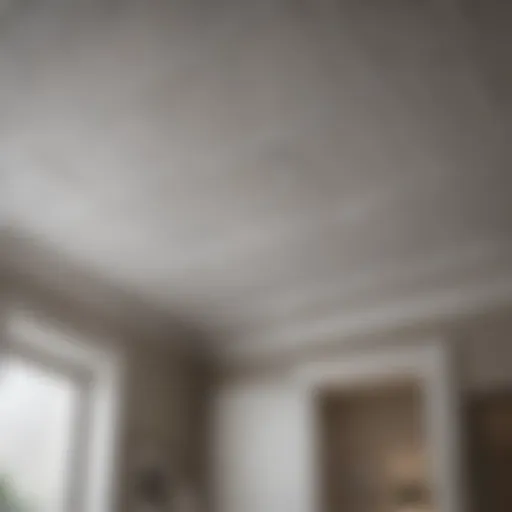The Beauty and Benefits of Painted White Panelling
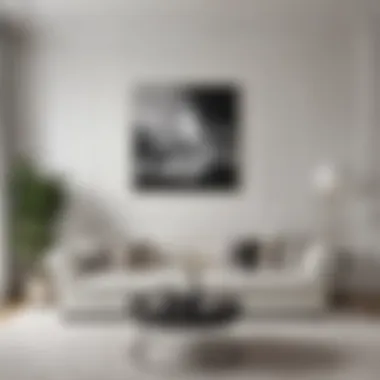

Intro
In the world of interior design, few elements can match the versatility and charm of painted white panelling. This design choice is not just about aesthetics; it serves multiple practical purposes in a home. It’s a strategic way to create a sense of space, reflect light, and harmonize various design elements. Homeowners and design enthusiasts alike are often drawn to the crisp, clean look of white panelling, which opens up a palette of possibilities for creativity and expression.
The implications of painted white panelling stretch far beyond mere appearances; they influence the very atmosphere of a room. Whether you’re aiming for a rustic farmhouse vibe or a sleek modern look, painted white panelling can adapt and elevate your design aspirations. Let’s dive into the nuances of this design choice, beginning with some essential tips to enhance your interior spaces.
Interior Design Tips
Trendy Design Ideas
Painted white panelling can play a starring role in a variety of trendy themes. For instance, consider a Scandinavian-inspired room, where the bright white paired with natural wood tones can create a serene and uncluttered environment. Similarly, the coastal theme benefits from white panelling's capacity to mimic the shoreline, inviting lighter shades of blues and sandy hues into the palette. Furthermore, mixing textures can be bold and beautiful; imagine combining smooth painted panels with a rough wooden beam overhead.
Color Schemes and Combinations
When working with painted white panelling, the right color combinations can make all the difference. Some popular choices include:
- Soft Grays: For a subtle, sophisticated look that still feels airy.
- Navy Blue or Emerald Green: These delves into deeper hues create a striking contrast against white, highlighting the panelling.
- Pastel Shades: Shades like soft pink or mint green can add a touch of whimsy while maintaining a soothing atmosphere.
It’s also helpful to consider accent colours that might come through furniture or decor. A well-placed charcoal sofa or a vibrant piece of art can bring life to an otherwise monochromatic setting.
Furniture Arrangement Techniques
How you arrange furniture in a room with painted white panelling can significantly impact the feel of the space. An open layout can enhance the sense of airiness often associated with white walls. Key techniques include:
- Floating Furniture: Avoid pushing everything against the walls. Getting pieces off the walls can help create a more inviting and conversational layout.
- Symmetrical Groupings: To play up the elegance of the painted panelling, consider symmetrical arrangements to bring balance.
By paying attention to these details, the white panelling becomes a backdrop that makes other elements shine.
Establishing Psychological Effects
Beyond the design and aesthetic advantages, painted white panelling also has psychological impacts worth considering. White is often associated with purity, innocence, and simplicity. This can evoke a sense of calm and openness, turning your home into a refuge. Moreover, white reflects light, which can enhance mood and energy levels within the space. Thus, incorporating this element thoughtfully can transform an ordinary room into a tranquil oasis, fostering relaxation.
"White space is to be regarded as an adequate by-product of color's presence; without darkness, there's no light."
— Designer Gregory Rosenburg
In wrapping up the interior design section, it becomes evident that painted white panelling serves as a canvas. It allows for personal expression while providing a sense of coherence and sophistication.
Let’s next explore how this elegant design choice can also play a role in entertaining essentials, enriching your home experience further.
Preface to Painted White Panelling
Painted white panelling has become a prominent feature in the design of both homes and commercial spaces. Its appeal lies not just in the striking visual aspect but also in practical benefits that cater to a variety of needs. This introduction serves as a springboard to explore why painted white panelling has carved a niche in contemporary design over the years, offering insights into the ways it can positively affect the aesthetic and functional qualities of a space.
The term "white panelling" encapsulates various styles, from classic wainscoting to sleek modern designs. The neutrality of white allows it to blend seamlessly with any color palette, enhancing the vibrancy of adjacent decor rather than competing with it. Also, this neutrality invites creativity. It becomes a blank canvas for interior designers and homeowners alike, giving way to limitless possibilities in design execution.
Furthermore, choosing white isn’t merely about the surface hue; it taps into psychological aspects of color theory and emotional responses. In interiors, white can evoke feelings of cleanliness, simplicity, and tranquility, making it a favored choice for bedrooms, living spaces, and even commercial locales that aim for a refreshing atmosphere.
Through the upcoming sections, we will dissect the various dimensions of painted white panelling, shedding light on its aesthetic appeal and practical implications. Such insights will surely resonate with homeowners, interior design enthusiasts, and anyone looking to transform their spaces into something extraordinary.
Defining Painted White Panelling
Painted white panelling refers to the use of wooden or engineered panels, coated with a white paint finish, to enhance wall surfaces. This approach allows for various types of panelling styles—from beadboard to shiplap—and can be tailored according to personal preference or architectural integrity of a home. Essentially, it involves either adding new panels to walls or painting existing surfaces white to achieve a similar effect.
Historically, panelling was widely used for its functional benefits, offering insulation and protection to walls. Today, the aesthetic dimension has risen to the forefront. White paints lend versatility, effortlessly shifting between rustic charm and sleek modernism depending on the surrounding furnishings and decor.
Historical Context and Evolution
The roots of panelling stretch back across centuries, initially gaining prominence as a means of both insulation and decoration in homes. In the past, ornate wooden panelling served as a status symbol for the wealthy, often taking the form of intricate carvings. Over time, as societies evolved and design preferences shifted, the use of painted surfaces emerged as a more accessible alternative.
In more recent history, particularly through the 20th century, the minimalist movement embraced white as a key player in interior design. This shift emphasized a clean and spacious atmosphere that painted white panelling naturally epitomizes. The rise of open-concept living has propelled white panelling into the spotlight as it creates an illusion of larger spaces, seamlessly transitioning from one area to another while maintaining an inviting vibe.
Today, we witness a fusion of styles that incorporate painted white panelling, from mid-century modern to bohemian, reflecting its remarkable adaptability and timeless appeal. As we dive deeper into the article, we will reveal the specific aesthetic advantages, practical considerations, and psychological impacts that painted white panelling presents.
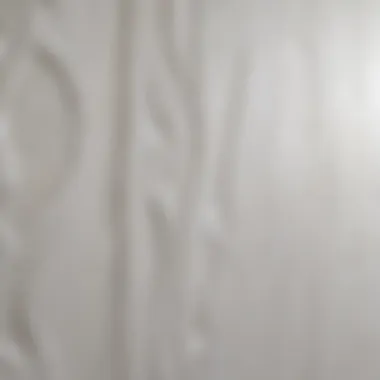

Aesthetic Benefits
The role of painted white panelling in interior design extends far beyond the simple act of applying color to walls. It serves as a fundamental contributor to an environment’s aesthetic value. By examining the aesthetic benefits of painted white panelling, we'll see how it not only brightens a room but also shapes the ambience in which we live, work, and interact. The key impact of this design choice is its versatility—allowing it to fit into various styles and enhance how we feel about our spaces.
Enhancing Light and Space
One of the most compelling reasons to use painted white panelling is its ability to reflect and amplify natural light. Light-colored surfaces tend to bounce back sunlight, making a room feel larger and airier. When a room is painted in white, it achieves an illusion of openness, which is particularly beneficial in smaller spaces or in areas lacking sufficient windows.
Consider a cozy living room with dark, heavy furniture and muted wall colors. Introducing white panelling can transform this space into a bright retreat. Instead of feeling like you're in a cave, you'll enjoy an atmosphere that feels more spacious and inviting. The play between light and the textured panelling adds dimension, creating a wider sensory experience than a flat wall could offer.
Creating a Timeless Look
Another aesthetic advantage is the timelessness that painted white panelling provides. It's a classic choice that never seems to go out of style. Unlike trendy colors that may quickly feel outdated, white panelling maintains a sense of immediate elegance. It can seamlessly blend into both contemporary and traditional settings, ensuring that the investment remains relevant through changing design trends.
For example, picture a farmhouse with white shiplap panelling contrasted against rustic wooden accents. This look never feels tired and stands the test of time. Its adaptability allows homeowners to easily switch up furnishings and accessories without feeling tied down by the wall colors.
Compatibility with Various Design Styles
Modern Interiors
In modern interiors, painted white panelling is more than just a background feature; it reinforces the minimalistic ethos central to this design style. The sleek, clean lines created by white panelling pair well with contemporary furniture and accessories, contributing to an uncluttered visual narrative. A noteworthy characteristic of modern interiors is the emphasis on functional beauty, and white panelling achieves just this by acting as an understated yet striking element. However, one drawback might be that too much white can feel sterile, so it's important to mix textures and decor to keep the space warm and inviting.
Traditional Aesthetics
Traditional aesthetics often shine brightest with the aid of white panelling where craftsmanship and detail take center stage. It enhances the intricate moldings and trim that characterize this style. The nuanced whiteness can add to the drama—consider a Victorian or Georgian home where richness in detail is paramount. The downside, though, is that it can sometimes feel too formal or rigid, depending on how it's executed. Yet, when done right, it provides a timeless elegance that contributes to the character of a home.
Eclectic Designs
Eclectic designs celebrate individuality and variation, and painted white panelling serves as the perfect canvas. By providing a neutral backdrop, white panelling allows for bursts of color and unique pieces to stand out without overwhelming the space. Its versatility means it can accommodate a mix of styles from vintage to modern. The beauty of eclectic design lies in its almost playful rule-bending nature, but a potential downside is that it may risk looking too haphazard if not carefully curated. Ultimately, white panelling lets eclectic elements shine and is a beneficial choice that creates cohesion amid diversity.
Painted white panelling is not just about aesthetics; it’s involved in shaping how we perceive and interact within our environments, providing a backdrop that harmonizes the diverse elements of interior design.
Psychological Impact of White
In discussing painted white panelling, the impact of colour extends far beyond mere aesthetics. White, often perceived as blankness, is instead loaded with psychological nuances that shape our response to a space. It plays a pivotal role in how we experience and interpret our environments. When incorporated into interior design, painted white panelling can create feelings of comfort, calmness, and clarity, making it a powerful tool for design enthusiasts and homeowners alike.
Perception of Space
One significant aspect is how white can influence the perception of space. When a room is enveloped in white, it can create an illusion of expansiveness.
- Light Reflection: White panelling reflects natural and artificial light effectively, making rooms feel brighter and airier. The way light bounces off white surfaces brings a dynamic quality to interiors, altering perceptions as the sun moves across the sky.
- Boundless Horizons: Imagine stepping into a room where the walls seem to stretch into infinity. This is the magic of white panelling. By minimizing visual barriers, white walls eliminate the feeling of confinement, making even small spaces feel larger than life.
- Enhancing Architecture: For spaces with unique architectural features, white panelling highlights elements without overshadowing them. Beams, moldings, and shapes are accentuated, drawing the eye upward and outward, inviting exploration.
In essence, white has the power to create an inviting environment that feels comfortable and spacious, making it ideal for various applications, be it in residential or commercial contexts.
Emotional Responses to Colour
The emotional weight that colour carries is often understated. White, as a colour, evokes distinct responses that can influence moods and feelings within a space.
- Serenity and Peace: Commonly associated with purity and simplicity, white has a calming effect. Living and working in white rooms can soothe anxiety and create a peaceful mindset, essential for both relaxation and productivity.
- Clarity of Thought: A white-walled environment can enhance focus; distractions are minimized when there is little visual noise. Home offices, libraries, and study areas can greatly benefit from this.
- Cultural Variance: Interestingly, the meaning attached to white can vary across cultures. In Western societies, white often symbolizes purity, while in others it may symbolize mourning. Understanding these nuances is crucial for thoughtful design that respects these variations.
"Colour is a power which directly influences the soul." - Wassily Kandinsky
In summary, the psychological impact of white painted panelling broadens the scope of interior design, offering homeowners and design aficionados unique opportunities to create both visually and emotionally resonant spaces. A careful consideration of colour not only determines the visual appeal of a room but also its psychological and emotional ambiance, turning every painted wall into a silent storyteller.
Practical Considerations
When it comes to painted white panelling, practical considerations cannot be overlooked. This is not simply about aesthetics, but rather about ensuring that the choice you make is as functional as it is beautiful. After all, it's one thing to have a lovely space but quite another to maintain and enjoy that space over time. Understanding the practicalities upfront can save you a lot of headaches down the line.
Choosing the Right Paint
Type of Paint
Selecting the right type of paint is crucial in achieving a finish that stands the test of time. Latex paint, for instance, is often the go-to choice for many homeowners because it dries quickly and cleans up easily with just soap and water. This characteristic makes it a popular pick, especially for those who might not be seasoned DIYers.
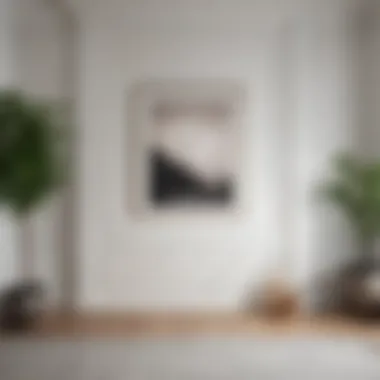

One unique feature of latex paint is its flexibility. It can expand and contract with temperature changes, which reduces the chances of cracking—a common issue in wooden panelling. However, it may not always provide the toughness needed for high-traffic areas. On the other hand, oil-based paints offer a durable finish but come with longer drying times and require solvents for cleanup. In some cases, the initial higher difficulty might be a deterrent for inexperienced users, but the long-lasting results can make it worthwhile.
Finish Selection
Move on to finish selection, and you find it plays a vital role too. A glossy finish can give your panelling an elegant shine, making it easier to wipe clean. This sheen reflects light beautifully while enhancing the depth of your white panelling. However, it tends to highlight surface imperfections, so a bit of extra prep work might be needed to get it just right.
Conversely, a matte finish can impart a soft, understated aesthetic that works wonderfully in cozy spaces. While it masks imperfections better than its glossier counterpart, it can be less resilient to stains and guidance should be given on how to care for it properly. Thus, the choice between glossy or matte requires consideration of both style and functionality for the spaces they occupy.
Application Techniques
Preparation of the Surface
Any seasoned painter will tell you, the secret to a flawless paint job lies in the preparation of the surface. This is an area where one can’t afford to cut corners. A properly prepared surface will hold paint better, making your panelling look great for years to come. It involves cleaning off any dirt and grease, sanding the surface smooth, and filling in any holes or imperfections with a good-quality filler.
The beauty of this approach is that it sets a solid foundation for your new paint. Think of it as laying down the groundwork before building a house—the sturdier the base, the better the results. Not having a suitable surface can lead to peeling or bubbling paint down the line, which is not only unsightly but can also lead to more extensive repairs.
Priming and Painting Steps
Priming is another essential step that often gets skipped, but that can be a big mistake. Primers are designed to help the paint adhere better, provide an even base, and can even block stains from bleeding through. When applied properly, it can significantly improve the durability and finish of the paint job. This is particularly true for white panelling, which requires a high-quality primer to prevent any underlying colors or patterns from seeping through.
Once primed, the painting process itself is where the real magic happens. Using a roller or a paint sprayer can yield excellent results, but brushes are handy for getting into corners and details. The key here is applying the paint in thin, even coats; it’s better to do two light coats than one heavy one. This method helps achieve a uniform look and can diminish the chances of drips and uneven surfaces.
Maintenance and Care
Cleaning Methods
Cleaning painted white panelling may sound straightforward, but the method chosen can make a significant difference in maintaining its appearance. Using a soft cloth with mild soap and water can typically do the trick, ensuring that the finish remains intact while avoiding harsh chemical cleaners that can strip the paint over time. A gentle limpieza avoids damaging sensitive surfaces and keeping on top of dirt can prolong the beauty of the panelling.
It's worth noting that routine maintenance doesn’t just keep aesthetics in check; it can also protect against more significant issues that might require relayering or repairing, making it a beneficial practice in the long run.
Touch-Up Techniques
No matter how careful you are, touch-ups are sometimes inevitable. Learning a few touch-up techniques can be a godsend. Keeping a small can of leftover paint handy can save you a lot of stress when a minor bump occurs. Using a fine brush can help apply paint to those pesky spots you need to redo without disturbing the surrounding area much.
One unique aspect of touch-ups is ensuring they blend well with the existing paint. This may require some finesse, as drying times can vary. Therefore, timing can be crucial. A spot that dries too quickly may not match a neighboring area that stayed wet a bit longer. Always test a small area first if there's any doubt.
"Choosing the right paint and maintaining it as well are keys to enjoying the beauty of your white panelling for years to come."
In summary, addressing each of these practical considerations will enhance not only the aesthetic pleasure of painted white panelling but its functionality and durability as well.
The Role of Lighting
Lighting plays a critical role in how painted white panelling is perceived within a space. The dynamism of light affects colors and textures, creating different moods and experiences. For homeowners and interior design enthusiasts, understanding the interaction between light and white panelling can enhance the overall aesthetic and functionality of their environments.
Natural Light Interaction
When it comes to natural light, painted white panelling shines its brightest. Natural light has a way of bouncing off white surfaces, making rooms feel more spacious and airy. Here, the glow of sunlight can bring depth to the crispness of white, creating an inviting atmosphere.
- Light Reflection: White panelling reflects between 80% to 90% of the light that hits it. This not only brightens the room but also alleviates the feeling of confinement often found in darker interiors.
- Changing Ambiences: The intensity and angle of sunlight change throughout the day, transforming the look of white panelling. In the morning, a soft, warm light might highlight the grain of the wood, while the afternoon sun can create a more vibrant, almost ethereal glow.
In the winter, rooms might feel cheerful and cozy with warm sunlight filtering through. However, during peak summer, the same panelling can take on a cooler, almost refreshing appearance, helping to combat the heat. This adaptability makes it particularly well-suited for homes in regions with diverse climates.
"The true beauty of painted white panelling lies in its ability to morph under natural light, providing endless opportunities for aesthetic enjoyment."
Artificial Lighting Considerations
In an era where artificial lighting is an integral component of interior design, understanding its impact on painted white panelling is paramount. From the warmth of incandescent bulbs to the sleekness of LED lights, the type of artificial light can significantly alter the ambiance.
- Wattage and Color Temperature: Warmer color temperatures (around 2700K to 3000K) create a soft, inviting atmosphere, making white panelling feel welcoming. Cooler temperatures (5000K and above) can lend a more clinical and spacious feel but could wash out finer details of the panelling.
- Layering Lights: The technique of layering different light sources—ambient, task, and accent lighting—can create a visually interesting environment. Using dimmable fixtures allows homeowners to play with light intensity and mood, optimizing how their white panelling interacts with other design elements.
- Highlighting Features: Properly placed spotlights or track lighting can emphasize the texture of panelling, allowing its details to pop. This can elevate a space's sophistication, especially in settings like galleries or modern lofts.
In summary, the relationship between lighting—the natural and artificial types—and painted white panelling is one of synergy. By harnessing light effectively, one can optimize the potential of white panelling in any design context, whether it be a residential or commercial space.
Case Studies
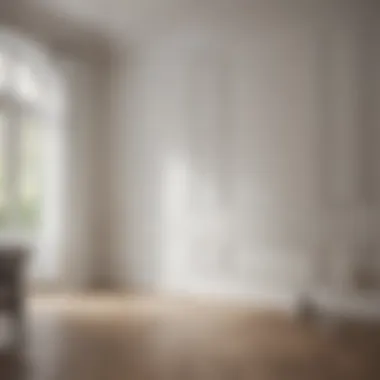

Case studies are a critical component of understanding the practical implications and aesthetic benefits of painted white panelling. They serve as real-world examples that illustrate how individuals and businesses leverage this design element to enhance their spaces. These cases provide evidence of the versatility and effectiveness of white panelling in various contexts, making it easier for homeowners and design enthusiasts to grasp its potential.
When analyzing case studies, several key elements emerge.
- Real-life Applications: They showcase the different ways that painted white panelling can be employed, whether in homes, offices, or retail spaces.
- Visual Evidence: Images and descriptions reveal the outcomes of using white panelling, helping readers to visualize its impact on light, space, and ambiance.
- Practical Insights: The studies often include challenges faced during implementation, offering lessons and tips for future projects.
"A well-curated space is not just about aesthetic appeal; it’s about functionality, sustainability, and comfort. Case studies reveal best practices to achieve this."
Through these detailed explorations, readers gain inspiration and confidence to consider painted white panelling for their own environments.
Residential Applications
In residential settings, painted white panelling can transform a room, lending an air of freshness and spaciousness to even the most compact areas. One noteworthy example comes from a townhome in a bustling urban environment, where the owners opted for white wall panelling in their living area. The resulting effect was remarkable; the walls reflected natural light streaming in from large windows, making the room feel wider and more inviting. This approach also provided a blank canvas for art and décor, allowing personal touches to shine through without the distraction of bold wall colors.
Considerations for using white panelling in homes include:
- Style Cohesion: White panelling complements various interior styles, from minimalist to traditional, allowing for seamless integration.
- Durability: Residential applications often involve coated finishes that can withstand the wear and tear of everyday life, making painted panelling practical for high-traffic areas.
- Customization: Homeowners can choose from a variety of trim styles and panel configurations to tailor their spaces to their tastes.
Ultimately, the use of painted white panelling in residential spaces is a solid choice for those seeking to elevate their homes' aesthetic and practical appeal.
Commercial Spaces
Painted white panelling is increasingly becoming a staple in commercial spaces as well, where branding and ambiance play a crucial role in customer experience. A striking instance can be seen in a boutique hotel that utilized white panelling throughout its lobby and corridors. The clean lines of the panelling enhanced the sense of openness, encouraging guests to relax and explore the space. Not only did this contribute to an inviting vibe, but it also served practical purposes by providing a durable and easy-to-maintain surface that could handle the hustle and bustle of hotel life.
Benefits of employing white panelling in commercial environments encompass:
- Professional Appearance: Clean white walls project a polished image, appealing to clients and visitors alike.
- Versatile Branding: The neutrality of white allows for flexible decoration, enabling businesses to easily switch out artwork or branding elements.
- Enhanced Lighting: In spaces like retail or dining, white panelling reflects light effectively, creating a bright atmosphere that draws customers in.
In the end, from residential comfort to commercial professionalism, painted white panelling holds the ability to redefine spaces, underscoring its enduring appeal in contemporary design.
Future Trends in Panelling
As we step into an era where sustainability and innovation take center stage, the realm of painted white panelling is undergoing a significant transformation. Understanding these future trends helps homeowners and design enthusiasts make informed choices that resonate with both aesthetic and practical aspirations. Sustainable materials and innovative coating technologies are two elements that stand out, promising to redefine the use of panelling in our spaces.
Sustainable Materials
The growing emphasis on environmental responsibility has led to a surge in the popularity of sustainable materials. These materials not only reduce the ecological footprint but also offer unique aesthetic qualities that can enhance the appearance of white panelling.
- Recycled Wood: Using reclaimed wood for panelling not only tells a story but also minimizes the amount of new timber harvested. Each piece has its own character, offering varied textures that can complement a fresh coat of white paint.
- Bamboo: Known for its rapid growth, bamboo is an excellent option. It gives a light and airy feel to interiors, aligning perfectly with the ethos of painted white panelling.
- Low-VOC or Zero-VOC Paints: These paints are becoming increasingly available, ensuring that the finishing touches contribute to healthier indoor air quality without compromising on aesthetics.
"Choosing sustainable materials is not just a trend; it's a commitment to our planet and future generations."
Innovative Coating Technologies
In the march towards modernization, innovative coating technologies have emerged as a game changer. They offer homeowners and designers a blend of durability and visual appeal that enhance the longevity of painted white panelling.
- Self-Cleaning Surfaces: Coatings that repel dirt and grime are becoming more prevalent. This leads to less maintenance and keeps panelling looking fresh and bright.
- Smart Paints: Smart coatings can change color with temperature or respond to various environments, introducing a whole new dimension to how spaces can be perceived.
- Textured Finishes: Instead of opting for flat paint, textured finishes add depth and interest, while still maintaining the classic look of white panelling. This allows for a sophisticated blend of modern and traditional design principles.
End
The conclusion acts as a culmination of the ideas explored throughout the article, reinforcing why painted white panelling merits serious consideration in interior design. This practice isn’t just about aesthetics—it's also tied to functionality, emotional impact, and long-term usability. Whether one opts for a complete transformation or selective applications within a space, the implications of using painted white panelling are significant.
Recap of Key Points
To summarize, the article highlighted the following key aspects:
- Aesthetic Benefits: Painted white panelling enhances light and space, creates a timeless look, and complements diverse design styles, ranging from modern to traditional.
- Psychological Impact: The perception of space expands with the clever use of white, which can evoke calmness and serenity within a home.
- Practical Considerations: Important factors regarding paint selection, application techniques, and maintenance routines were discussed to aid homeowners in their decision-making processes.
- Future Trends: As we move towards sustainable choices, innovations in materials and coatings will likely shape the future of panelling.
By understanding these pillars, readers glean the depth of potential painted white panelling offers for both charm and utility.
Final Thoughts on White Panelling
As interior design continues to evolve, painted white panelling stands out due to its versatile nature and adaptive qualities. It can transform a narrow hall into a broader passage or turn a humble room into an airy oasis. Moreover, the emotional weight of white—often linked to purity and clarity—can reshape how inhabitants perceive and interact with their surroundings.
While considerations such as ongoing maintenance and emotional responses are essential, the advantages generally outweigh the challenges. Infusing spaces with painted white panelling not only elevates the design but also enriches one's living experience. For homeowners, designers, and anyone passionate about creating welcoming environments, painted white panelling is not simply a decorative choice; it is a strategic enhancement that resonates with both aesthetic sensibility and practical needs.
"Painted white panelling is not just about style; it embodies a promise of light, space, and timeless appeal."
In the grand scheme of home design, painted white panelling is a testament to how simplicity can yield profound beauty and functionality.

